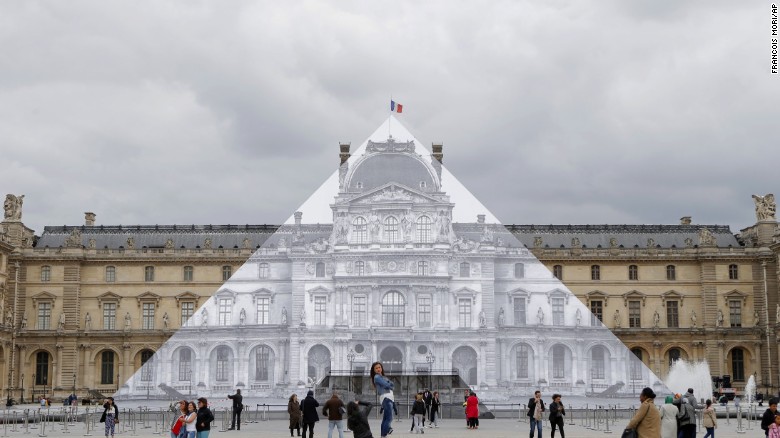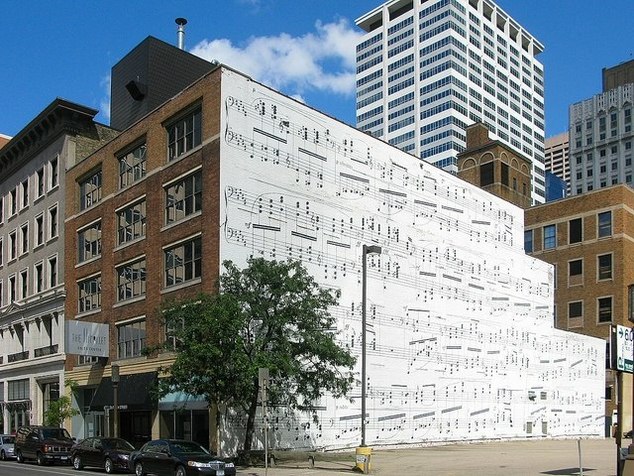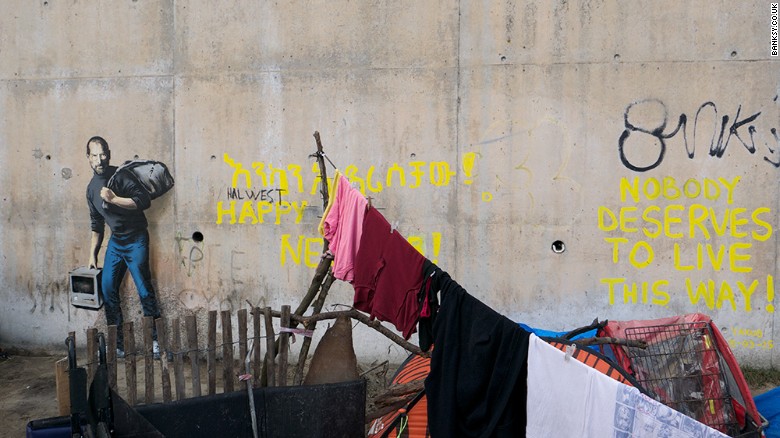-
Cavacava
2.4kOver the last thirty years, street artists have left the gallery and they have gone into communities around the world putting their art on the local architecture. Unlike Graffiti, in which highly stylized forms of abstract figures is put on walls, the predominate forms of Street Art are realistic human/animal figures presented in unexpected places.
Realism is utilized as a counternarritive to cultural/political trends that artist thinks predominate in society. It sets itself against Idealism in its choice of the poor, the downtrodden, as well as depiction of the local population in subversive ways. Its mimesis points to a reality beyond itself.
The movement goe beyond the gallery, to confront a population by presenting realist art which is framed by the architecture it uses as its 'frame' tries to give that population a glance at itself, one that it would not otherwise see.
There are many Street Artists and I like much of the work I see. Banksy, JR are well known, but it seems as though most major urban areas have their own local talent. I posted this thread due to a work that JR did over the last week at the Louvre in Paris.

The realism of JR's work disrupts our view, his photographic illusion brings back the nostalgic view, our view prior to the reality that IM Pei's pyramid. Pei's pyramid was an ideal attempt to merge the new with the old in his spectacular transparent pyramid. It fits in its surroundings.
Street Art is concerned with the people who live where the art is shown. In some cases the population who live and work in close proximity to this art have taken a sense of ownership of the work. I read that one work changed the way people set about their day, making a pass by part of their daily routine.
The next phase in Art must go beyond Critique, to arrive a new inclusive narrative, the way Street Art is progressing in my opinion. -
 BC
14.1kIn a drive to suppress graffiti on utility boxes that are located next to sidewalks and bikeways, local telecom and electric companies have offered some of its boxes as art-surfaces. It is pleasant to encounter the utility-box-canvases.
BC
14.1kIn a drive to suppress graffiti on utility boxes that are located next to sidewalks and bikeways, local telecom and electric companies have offered some of its boxes as art-surfaces. It is pleasant to encounter the utility-box-canvases.
It is, in a way, surprising that more property owners don't offer up their beige concrete block walls facing empty lots and thousands of passersby to local artists. There are benefits to having art on one's exteriors: locals psychologically invest in the building; taggers generally do not deface the walls; it's good PR; it enhances the neighborhood, and may increase the real estate value of the building.
"Disruptive" can be annoying and irritating. Street art should, after all, still be art and not just garish paint slapped on an otherwise unoccupied surface. Bad paint jobs aren't much better than inelegant graffiti (IMHO). Disruptive also can not be programmed. If Walmart, for instance, got involved in approving the street art to be applied to its dreary exteriors, it certainly would not be disruptive.
There are walls that beg for art, for an image. The two oldest gay bars in the Minneapolis both have walls facing their parking lots in neighborhoods where "sponsored disruptive art" would be welcomed. The Happy Hour's two floor wall facing a parking lot is a utility-grade tan brick wall dating back to the 1930s. It's the kind of wall that the builder probably assumed would not be visible for the next 80 years. It's a perfect wall for a black and white vintage gay image. In 1970 it would have been flat out disruptive on all sorts of levels and would not, therefore, have happened. In 2016 this sort of image would be visually disruptive, but socially acceptable.
The 19 Bar (its address on 15th Street) is a small concrete block affair in what used to be the heart of Minneapolis's pretty much vanished "gay ghetto", such as it was. It's been painted; it looks better than it used to, but it was painted to not-disrupt-in-any-way.
Schmitt Music Company building in Minneapolis (this mural has been disruptive for at least 40 years old now.) The image is a passage from a Ravel's Gaspard de la Nuit.

-
Cavacava
2.4kI like the Schmitt Music Company building.
I was thinking more along the lines of

This is JR in NYC. The walkway was an above ground train or road, which the City abandoned and then turned into a walkway park, which is very popular. JR gets around, his project in Havana 2012 is inspiring...the video he did shows how he managed to get neighborhood people involved in his artwork.
https://youtu.be/BD2VWmxW1nk
It reminded me of the previous video you posted of the Crown Fountain in Chicago, the artist took faces from the local community to play in circuit on fountain's face.
https://youtu.be/BD2VWmxW1nk
Other more subversive:

Banksy said: “We’re often led to believe migration is a drain on the country’s resources but Steve Jobs was the son of a Syrian migrant. Apple is the world’s most profitable company, it pays over $7bn (£4.6bn) a year in taxes – and it only exists because they allowed in a young man from Homs.”
It is a positive message, not a negative. Much of the Street Art, I am interested in, places a photo/stencil
in place where it surprises the viewer, unexpected, framed by its normative context. It poses almost a dialectic relationship between its reality and the reality of its context. The more realistic the work, the greater the contrast between itself and what is expected, what we experience all the time.
Up until very recently there was a sense of temporality to most of these works. The city only saw them as criminal defacements and sent out the work crews to whitewash, to purify the city's walls. Many of the major artists such as JR, Shepard Fairey, and others use wheat paste to put up their works. The works have built in temporality.
The Modern era saw artworks that became progressively more abstract, then art went schitzo, it became about itself, it became Postmodern, critical of itself, & any totality. I think some Street Artists are trying to go beyond the critical to embrace a community idea of art, one that shapes lives by romancing the particular. Post-Critique. -
 BC
14.1kThis mural was painted on the exterior wall of the United Food and Commercial Workers (UFCW) Union hall, local P9, Austin Minnesota, 1986. Mike Alewitz was the artist. The banner reads "If blood be the price of your cursed wealth, good God we have paid in full." I can't remember whether the mural was painted with the assistance of strikers, or not.
BC
14.1kThis mural was painted on the exterior wall of the United Food and Commercial Workers (UFCW) Union hall, local P9, Austin Minnesota, 1986. Mike Alewitz was the artist. The banner reads "If blood be the price of your cursed wealth, good God we have paid in full." I can't remember whether the mural was painted with the assistance of strikers, or not.
It was painted on behalf of the militant strikers in P9. The reference to cost in blood is especially appropriate. Meat packing is inherently dangerous, especially in massive, assembly-line, company-controlled plants where the speed of the line is too fast and production requirements are too high. At the time of the strike, the injury rate in the plant was 100% -- every worker could expect (on average) a significant injury at least once a year. Today the ununionized plant has a higher rate of injuries than it did in 1985.
If you happen to be in Austin, MN (maybe to tour the Hormel slaughterhouse and meat products factory) do stop by and have a look. You won't see much. Soon after the mural was completed, it was attacked by power washers and steel brushes. The UFCW (and maybe Hormel) weren't about to let this sort of subversive, transgressive, slap in their face just sit there. It reminds one of Rockefeller's destruction of one of Diego Rivera's murals in Rockefeller Center, which included the likeness of Lenin.
The strike, like the mural, was lost. Hormel 10, workers 0. Strike breaking by companies is bad enough, but strike-wrecking by the national union bureaucrats is even worse.

-
 BC
14.1kAustin Minnesota — Bitter Crank
BC
14.1kAustin Minnesota — Bitter Crank
Austin is a small town - maybe...25,000, if that. It's a one-company town--Hormel.
One does not see many (any?) explicitly left/labor murals in a large city (like MPLS) much lest a small burg like Austin. One does see small flames of discontent in graffiti. In the toilet of the Riverside Cafe there was, once, this (I saw it with my own eyes. Didn't have a camera back then):
Someone had written: "I am a pimple on the boss's ass."
Someone else had added: "Your task: become a running sore."
I would like to see more in that spirit.
Welcome to The Philosophy Forum!
Get involved in philosophical discussions about knowledge, truth, language, consciousness, science, politics, religion, logic and mathematics, art, history, and lots more. No ads, no clutter, and very little agreement — just fascinating conversations.
Categories
- Guest category
- Phil. Writing Challenge - June 2025
- The Lounge
- General Philosophy
- Metaphysics & Epistemology
- Philosophy of Mind
- Ethics
- Political Philosophy
- Philosophy of Art
- Logic & Philosophy of Mathematics
- Philosophy of Religion
- Philosophy of Science
- Philosophy of Language
- Interesting Stuff
- Politics and Current Affairs
- Humanities and Social Sciences
- Science and Technology
- Non-English Discussion
- German Discussion
- Spanish Discussion
- Learning Centre
- Resources
- Books and Papers
- Reading groups
- Questions
- Guest Speakers
- David Pearce
- Massimo Pigliucci
- Debates
- Debate Proposals
- Debate Discussion
- Feedback
- Article submissions
- About TPF
- Help
More Discussions
- Is the distinction between metaphysical realism & anti realism useless and/or wrong
- Michael Dummett on realism, anti-realism and metaphysics
- The meta-ethical semantics between moral realism and moral anti-realism
- Indirect Realism and Direct Realism
- Deletion by Streetlight X of my post on Race Realism and the Moral Fallacy
- Other sites we like
- Social media
- Terms of Service
- Sign In
- Created with PlushForums
- © 2025 The Philosophy Forum


